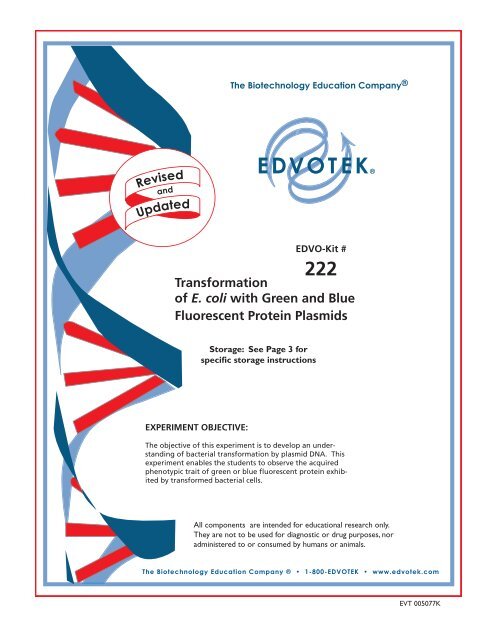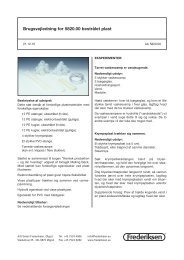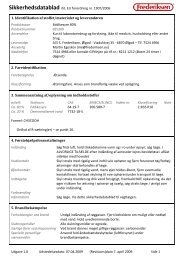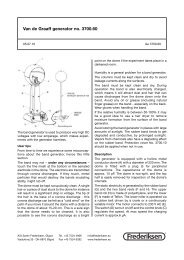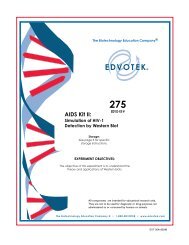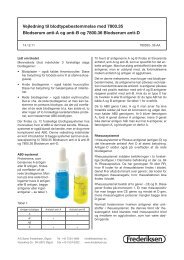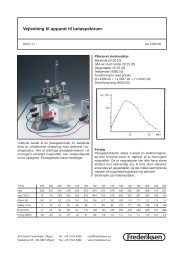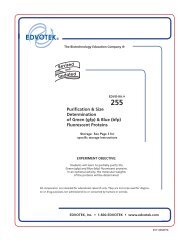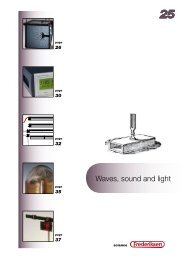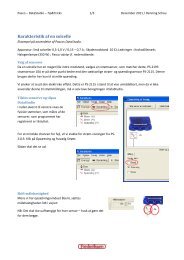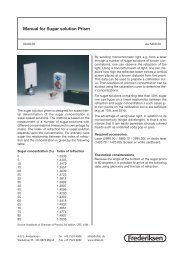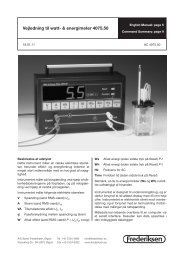Transformation of E. coli with Green and Blue ... - Frederiksen
Transformation of E. coli with Green and Blue ... - Frederiksen
Transformation of E. coli with Green and Blue ... - Frederiksen
Create successful ePaper yourself
Turn your PDF publications into a flip-book with our unique Google optimized e-Paper software.
<strong>Transformation</strong> <strong>of</strong> E. <strong>coli</strong> <strong>with</strong> <strong>Green</strong> <strong>and</strong><strong>Blue</strong> Fluorescent Protein PlasmidsEDVO-Kit # 222Bacterial <strong>Transformation</strong>Bioluminescence <strong>of</strong> marine microorganisms has been observed by manysummer visitors at beaches around the world. Onlookers are alwaysfascinated by the repeated parade <strong>of</strong> color <strong>and</strong> light on the s<strong>and</strong> duringthe ebb <strong>and</strong> flow <strong>of</strong> the tide. This observation pales to the lightproduced by the bioluminescent jelly fish Aquorea victoria, the naturalhost <strong>of</strong> the green fluorescent protein (GFP). A bright burst <strong>of</strong> light isobserved when energy is transferred to the green fluorescent protein(GFP) located in specialized photogenic cells in the base <strong>of</strong> the jellyfishumbrella. An excellent companion to GFP is the genetically engineered<strong>and</strong> well-characterized blue fluorescent protein (BFP).This family <strong>of</strong> proteins has been known for some time <strong>and</strong> significantresearch in this area has been reported. Fluorescent proteins can be expressedboth in prokaryotic <strong>and</strong> eucaryotic cells. These proteins do notrequire substrates, other gene products, or c<strong>of</strong>actors. When exposed tolong wave U.V. light, they emit a bright green or blue light that is visiblein bacteria transformed by plasmids that contain the genes encodingGFP or BFP. Likewise, purification <strong>of</strong> the GFP or BFP from crude proteinextracts is simplified by their fluorescence.Background InformationIn cell biology <strong>and</strong> molecular biology experiments, the GFP protein is<strong>of</strong>ten fused to other proteins to study various biochemical processes.There are many examples <strong>of</strong> chimeric fusion proteins using the GFP proteinas a biological tag. Such fusions are either at the N- or C- termini.The chimeric proteins are used as biotechnological tools to study proteinlocalization <strong>and</strong> trafficking <strong>with</strong>in cells.The green fluorescent protein (GFP) possesses a molecular weight <strong>of</strong>approximately 40,000 daltons. Most <strong>of</strong> the intact protein is requiredfor maintaining fluorescence; only small deletions <strong>of</strong> a few amino acidsare allowed to be altered <strong>with</strong>out compromising the integrity <strong>of</strong> theprotein structure. Interestingly, the chromophore responsible for lightemission is <strong>with</strong>in the structure <strong>of</strong> the GFP protein <strong>and</strong> resides in aminoacid residues 65 to 67, a cyclic tripeptide composed <strong>of</strong> Ser-Tyr-Gly. Theimportance <strong>of</strong> protein folding is clearly demonstrated in that the GFP isfluorescent only upon proper conformational folding.The blue fluorescent protein (BFP) is a variant <strong>of</strong> the GFP <strong>with</strong> a His toTyr substitution at position 66 <strong>and</strong> a second substitution from Tyr to Pheat position 145. With the crystal structure <strong>of</strong> GFP determined, severalother variants <strong>of</strong> the GFP have been constructed using site-directed mutagenesis(SDM). SDM allows specific (point) mutations to be introducedin a protein to determine the impact <strong>of</strong> that mutation on the proteinstructure <strong>and</strong> function. The set <strong>of</strong> GFP <strong>and</strong> BFP proteins can also be usedas a dramatic tool to visually demonstrate the effect <strong>of</strong> pivotal aminoacid changes on the structure <strong>and</strong> function <strong>of</strong> a protein. This, in turn,Duplication <strong>of</strong> this document, in conjunction <strong>with</strong> use <strong>of</strong> accompanying reagents, is permitted for classroom/laboratoryuse only. This document, or any part, may not be reproduced or distributed for any other purpose <strong>with</strong>out thewritten consent <strong>of</strong> EDVOTEK, Inc. Copyright © 1999, 2003, EDVOTEK, Inc., all rights reservedEVT 005077KThe Biotechnology Education Company ® • 1-800-EDVOTEK • www.edvotek.com
EDVO-Kit # 222<strong>Transformation</strong> <strong>of</strong> E. <strong>coli</strong> <strong>with</strong> <strong>Green</strong> <strong>and</strong><strong>Blue</strong> Fluorescent Protein PlasmidsBacterial <strong>Transformation</strong>Background Informationcan be used to help students to appreciate genetically inherited diseases<strong>and</strong> the effects <strong>of</strong> accumulated mutations on aging <strong>and</strong> the onset <strong>of</strong>various diseases.Bacterial transformation <strong>and</strong> Overexpression <strong>of</strong>Transformed GenesBacterial transformation is <strong>of</strong> central importance in molecular biology.<strong>Transformation</strong> is the process by which a bacterium takes up <strong>and</strong> expressesexogenous DNA, resulting in a newly acquired genetic trait thatis stable <strong>and</strong> heritable. This exogenous DNA can be recombinant DNAmolecules that have been constructed in vitro, as well as natural DNAmolecules. <strong>Transformation</strong> is also <strong>of</strong> historical importance since it led tothe discovery by Oswald Avery, in 1944, that DNA was the genetic material.In that historical experiment, Avery <strong>and</strong> colleagues purified DNAfrom a lethal strain <strong>of</strong> Streptococcus pneumoniae, removing all proteinfrom the DNA. This DNA was then transformed into a harmless strain<strong>of</strong> the same organism. Injection <strong>of</strong> the transformed, formerly harmless,strain into mice resulted in their death.For transformation to occur, bacterial cells must be in a particular physiologicalstate, referred to as competency, in which the bacterial cellwall is made permeable to macromolecules such as DNA. Competencycan occur naturally in certain species <strong>of</strong> Haemophilus <strong>and</strong> Bacillus whenthe levels <strong>of</strong> nutrients <strong>and</strong> oxygen are low. Competent Haemophiluscells express a membrane-associated transport complex that binds <strong>and</strong>transfers certain DNA molecules from the medium into bacterial cellsthat are then integrated into the bacterial chromosome <strong>and</strong> expressed.In nature, the source <strong>of</strong> the external DNA is from other cells that havedied <strong>and</strong> their cell walls lysed to release their DNA into the surroundingmedium.Much current research in molecular biology involves the transformation<strong>of</strong> E. <strong>coli</strong>, an organism that does not naturally enter a state <strong>of</strong> competency.E. <strong>coli</strong> can artificially be made competent when treated <strong>with</strong>chloride salts <strong>of</strong> the metal cations calcium, magnesium <strong>and</strong> rubidium.In addition, abrupt transitioning between heat <strong>and</strong> cold can induce competency.It is believed that metal ions <strong>and</strong> temperature changes affectthe structure <strong>and</strong> permeability <strong>of</strong> the cell wall <strong>and</strong> membrane, allowingDNA molecules to pass through the bacterial cell wall. Due to theirunstable cell walls, competent E. <strong>coli</strong> cells are fragile <strong>and</strong> therefore mustbe treated carefully.The number <strong>of</strong> cells transformed per 1 microgram (µg) <strong>of</strong> DNA is knownas the transformation efficiency. In practice, much smaller amounts <strong>of</strong>Duplication <strong>of</strong> this document, in conjunction <strong>with</strong> use <strong>of</strong> accompanying reagents, is permitted for classroom/laboratoryuse only. This document, or any part, may not be reproduced or distributed for any other purpose <strong>with</strong>out thewritten consent <strong>of</strong> EDVOTEK, Inc. Copyright © 1999, 2003, EDVOTEK, Inc., all rights reservedEVT 005077KThe Biotechnology Education Company ® • 1-800-EDVOTEK • www.edvotek.com
<strong>Transformation</strong> <strong>of</strong> E. <strong>coli</strong> <strong>with</strong> <strong>Green</strong> <strong>and</strong><strong>Blue</strong> Fluorescent Protein PlasmidsEDVO-Kit # 222Bacterial <strong>Transformation</strong>Number <strong>of</strong>transformantsµg <strong>of</strong> DNA100transformants0.01 µgXSpecific example:XDNA are used (5 to 100 nanograms, ng) since excessive DNA (>100 ng)inhibits the transformation process. For example, when 10 nanograms(0.01 microgram) <strong>of</strong> DNA was usedto transform cells that were in a finalfinal vol atrecovery (ml)vol plated (ml)1 ml0.1 mlFigure 1:Bacterial <strong>Transformation</strong> Efficiency Calculation==Number <strong>of</strong>transformantsper µg100,000(1 x 10 5 )transformantsper µgvolume <strong>of</strong> 1 ml, <strong>and</strong> if 0.1 ml (100 µl)<strong>of</strong> these cells were plated on mediumthat contained antibiotic, only thecells that acquired the foreign DNAcould grow. This procedure is calledselection. After incubation (in thisexample) 100 colonies were found onthe plate. Realizing that each colonyoriginally grew from one transformedcell, the transformation efficiency inthis example is 10 5 (outlined in Figure1). In research laboratories, transformationefficiencies generally rangefrom 1 x 10 7 to 1 x 10 8 cells per microgram<strong>of</strong> DNA. Special procedures canproduce cells having transformationefficiencies approaching 10 10 .The Experiment<strong>Transformation</strong> is never 100% efficient. Approximately one in every10,000 cells (<strong>of</strong> average competency) successfully incorporates exogenousDNA. However, based on the large number <strong>of</strong> cells (typically 1x 10 9 ), only a small number <strong>of</strong> cells are transformed to obtain visiblecolonies on agar plates.This concept can be demonstrated by plating the same volume <strong>of</strong> recoveredcells on selective <strong>and</strong> nonselective agar medium. The nonselectivemedium will have many more growing cells since all the untransformedcells survive, in addition to the transformed cells. The nonselectivebacterial agar plates will be covered heavily <strong>with</strong> untransformed cells,forming a “lawn”, in contrast to individual colonies obtained on theselective agar plate.To ferry foreign genes into bacteria, plasmids are usually used. Plasmidsare self-replicating extrachromosomal, double-str<strong>and</strong>ed circular DNAmolecules found in many strains <strong>of</strong> bacteria. Many plasmids containgenes that provide resistance to various antibiotics, including tetracycline,kanamycin, <strong>and</strong> ampicillin (amp). Ampicillin is a derivative <strong>of</strong>penicillin that inhibits bacterial growth by interfering <strong>with</strong> the synthesis<strong>of</strong> bacterial cell walls. The product <strong>of</strong> the ampicillin resistance gene isthe enzyme b-lactamase. This enzyme is secreted by transformed cellsinto the surrounding medium, where it destroys ampicillin. Due tothis extracellular secretion, cells that are not transformed are able toundergo limited growth in the zones surrounding transformed, antibiotic-resistantcells. Colonies consisting <strong>of</strong> these untransformed cellsDuplication <strong>of</strong> this document, in conjunction <strong>with</strong> use <strong>of</strong> accompanying reagents, is permitted for classroom/laboratoryuse only. This document, or any part, may not be reproduced or distributed for any other purpose <strong>with</strong>out thewritten consent <strong>of</strong> EDVOTEK, Inc. Copyright © 1999, 2003, EDVOTEK, Inc., all rights reservedEVT 005077KThe Biotechnology Education Company ® • 1-800-EDVOTEK • www.edvotek.com
EDVO-Kit # 222<strong>Transformation</strong> <strong>of</strong> E. <strong>coli</strong> <strong>with</strong> <strong>Green</strong> <strong>and</strong><strong>Blue</strong> Fluorescent Protein PlasmidsBacterial <strong>Transformation</strong>Background InformationSupercoiledRelaxedFigure 2: Supercoiled <strong>and</strong>circular forms <strong>of</strong> plasmid DNAsare called "satellites", since they only appear around larger colonies <strong>of</strong>transformed cells. Larger plating volumes <strong>and</strong> longer incubation timesincrease the number <strong>of</strong> satellite colonies.Plasmids naturally exist as supercoiled molecules. The twostr<strong>and</strong>s <strong>of</strong> DNA in the supercoiled molecule wind around eachother to produce a condensed, entangled structure when comparedto relaxed (non-supercoiled) DNA (Figure 2). CompetentE. <strong>coli</strong> cells are sensitive to the conformation <strong>of</strong> the DNA theywill accept. Supercoiled DNA gives the highest transformationefficiencies.SupercoiledpFluoro<strong>Green</strong>DNABacterialchromosomal DNA<strong>Green</strong>fluorescentproteinFigure 3Overview <strong>of</strong> GFP <strong>and</strong> BFP ExpressionIn this experiment, the goal is to express fluorescent proteins (GFP <strong>and</strong>BFP) in transformed bacterial cells. To begin this process, there must bea means <strong>of</strong> "turning on" the cloned GFP or BFP gene in the recombinantplasmid. In order to have an "<strong>of</strong>f/on" switch for controlling expression,the gene is placed under the control <strong>of</strong> a DNA sequence known as a"promoter".A promoter is a sequence in DNA that typically occurs just in front("upstream") <strong>of</strong> the DNA coding sequence (the sequence that specifiesthe amino acid sequence for a protein). The chromosome <strong>of</strong> the hostbacterial strain used in this experiment has been genetically engineeredto contain the gene for RNA polymerase, which is under control <strong>of</strong> thelac promoter, <strong>and</strong> can be turned on (induced) by the presence <strong>of</strong> a smallmolecule called IPTG (isopropyl-beta-D-thiogalactopyranoside). IPTGbinds to <strong>and</strong> inactivates an inhibitor protein known as the lac repressor.Duplication <strong>of</strong> this document, in conjunction <strong>with</strong> use <strong>of</strong> accompanying reagents, is permitted for classroom/laboratoryuse only. This document, or any part, may not be reproduced or distributed for any other purpose <strong>with</strong>out thewritten consent <strong>of</strong> EDVOTEK, Inc. Copyright © 1999, 2003, EDVOTEK, Inc., all rights reservedEVT 005077KThe Biotechnology Education Company ® • 1-800-EDVOTEK • www.edvotek.com
<strong>Transformation</strong> <strong>of</strong> E. <strong>coli</strong> <strong>with</strong> <strong>Green</strong> <strong>and</strong><strong>Blue</strong> Fluorescent Protein PlasmidsEDVO-Kit # 222Bacterial <strong>Transformation</strong>The sequence <strong>of</strong> events required to turn on expression <strong>of</strong> GFP/BFP is asfollows:1. Cells are grown in the presence <strong>of</strong> IPTG (to turn on the lac promoter)which binds to, <strong>and</strong> releases the lac repressor that sits on apromoter (lac) upstream <strong>of</strong> the RNA polymerase gene. The release<strong>of</strong> the inhibitor allows the RNA polymerase to be produced from theE. <strong>coli</strong> genome.2. The RNA polymerase, in turn, recognizes the promoter on theplasmid mRNA enabling production <strong>of</strong> large quantities <strong>of</strong> thefluorescent protein. In summary, a strong promoter, combined <strong>with</strong>an active RNA polymerase, allows for very high levels <strong>of</strong> GFP or BFPmRNA (<strong>and</strong> thus protein) expression in the transformed cells.Background InformationDuplication <strong>of</strong> this document, in conjunction <strong>with</strong> use <strong>of</strong> accompanying reagents, is permitted for classroom/laboratoryuse only. This document, or any part, may not be reproduced or distributed for any other purpose <strong>with</strong>out thewritten consent <strong>of</strong> EDVOTEK, Inc. Copyright © 1999, 2003, EDVOTEK, Inc., all rights reservedEVT 005077KThe Biotechnology Education Company ® • 1-800-EDVOTEK • www.edvotek.com
10EDVO-Kit # 222<strong>Transformation</strong> <strong>of</strong> E. <strong>coli</strong> <strong>with</strong> <strong>Green</strong> <strong>and</strong><strong>Blue</strong> Fluorescent Protein PlasmidsExperiment OverviewBefore you start the experiment1. Read all instructions before starting the experiment.The Experiment2. Write a hypothesis that reflects the experiment <strong>and</strong> predict experimentaloutcomes.Experiment Objective:The objective <strong>of</strong> this experiment module is to develop an underst<strong>and</strong>ing<strong>of</strong> the biological process <strong>of</strong> bacterial transformation by pFluoro<strong>Green</strong>or pFluoro<strong>Blue</strong> DNA. This experiment enables the students to observethe acquired phenotypic trait <strong>of</strong> green or blue fluorescent protein exhibitedby transformed bacterial cells.Brief Description <strong>of</strong> Experiment:In this experiment, you will transform a strain <strong>of</strong> competent E. <strong>coli</strong> whichhas no antibiotic resistance <strong>with</strong> supercoiled plasmid DNA which has agene for antibiotic resistance. Two plasmids are used for transformation.The plasmid that produces the green fluorescent protein containingthe GFP gene is pFluoro<strong>Green</strong>. The plasmid producing the bluefluorescent protein is pFluoro<strong>Blue</strong>. Both pFluoro<strong>Green</strong> <strong>and</strong> pFluoro<strong>Blue</strong>also possess the gene for ampicillin (amp) resistance.Bacterial cells will be selected for the presence <strong>of</strong> plasmid by platingthem on agar medium containing ampicillin. Only bacterial cells thattake up the plasmids will survive selection on ampicillin agar plates.When using pFluoro<strong>Green</strong>, green fluorescent colonies will be visibleunder long U.V. Light. Likewise, pFluoro<strong>Blue</strong> will be visualized asfluorescent blue colonies. If both plasmids are used in a single transformation,then a mixture <strong>of</strong> green <strong>and</strong> blue fluorescent colonies willbe visible. The transformation efficiency will then be estimated. Thefluorescent blue colonies will not be as highly fluorescent as the greencolonies.Duplication <strong>of</strong> this document, in conjunction <strong>with</strong> use <strong>of</strong> accompanying reagents, is permitted for classroom/laboratoryuse only. This document, or any part, may not be reproduced or distributed for any other purpose <strong>with</strong>out thewritten consent <strong>of</strong> EDVOTEK, Inc. Copyright © 1999, 2003, EDVOTEK, Inc., all rights reservedEVT 005077KThe Biotechnology Education Company ® • 1-800-EDVOTEK • www.edvotek.com
<strong>Transformation</strong> <strong>of</strong> E. <strong>coli</strong> <strong>with</strong> <strong>Green</strong> <strong>and</strong><strong>Blue</strong> Fluorescent Protein PlasmidsEDVO-Kit # 222 11Experiment OverviewStreak E. <strong>coli</strong> hostcells for isolationDAY BEFORE LABPrepare 5Source PlatesE. <strong>coli</strong> Cells- DNAPlasmid DNATransfer 2-4 large colonies to eachtube <strong>and</strong> completely resuspend+ DNA+pFluoro<strong>Green</strong> <strong>and</strong>/orpFluoro<strong>Blue</strong>10 µlThe Experiment250 µlCaCl 2Incubate on ice for15 minutesIncubate at 42°Cfor 90 secondsIncubate on icefor 2 minutes- DNAAdd 250 µlLuria Recovery Broth37°C for30 minutes+ DNAControlExperimentLB-LB/Amp - LB+IncubateIncubateLB/Amp +overnight in 37°Cincubation ovenovernight in 37°Cincubation ovenLB- LB/Amp - LB+ LB/Amp +LONG WAVE U.V. LIGHTIS REQUIREDTO OBSERVEFLUORESCENT COLONIES.Duplication <strong>of</strong> this document, in conjunction <strong>with</strong> use <strong>of</strong> accompanying reagents, is permitted for classroom/laboratoryuse only. This document, or any part, may not be reproduced or distributed for any other purpose <strong>with</strong>out thewritten consent <strong>of</strong> EDVOTEK, Inc. Copyright © 1999, 2003, EDVOTEK, Inc., all rights reservedEVT 005077KThe Biotechnology Education Company ® • 1-800-EDVOTEK • www.edvotek.com
12EDVO-Kit # 222<strong>Transformation</strong> <strong>of</strong> E. <strong>coli</strong> <strong>with</strong> <strong>Green</strong> <strong>and</strong><strong>Blue</strong> Fluorescent Protein PlasmidsLaboratory SafetyImportant READ ME!The Experiment<strong>Transformation</strong> experiments contain antibiotics which are used for theselection <strong>of</strong> transformed bacteria. Students who have allergies to antibioticssuch as penicilllin, ampicillin, kanamycin or tetracycine shouldnot participate in this experiment.1. Gloves <strong>and</strong> goggles should be worn routinely as good laboratorypractice.2. Exercise extreme caution when working <strong>with</strong> equipment which isused in conjunction <strong>with</strong> the heating <strong>and</strong>/or melting <strong>of</strong> reagents.3. Do not mouth pipet reagents - use pipet pumps or bulbs.4. The E. <strong>coli</strong> bacteria used in this experiment is not considered pathogenic.Although it is rarely associated <strong>with</strong> any illness in healthyindividuals, it is good practice to follow simple safety guidelines inh<strong>and</strong>ling <strong>and</strong> disposal <strong>of</strong> materials contaminated <strong>with</strong> bacteria.5. Properly dispose materials after completing the experiment:A. Wipe down the lab bench <strong>with</strong> a 10% bleach solution or a laboratorydisinfectant.B. All materials, including petri plates, pipets, transfer pipets,loops <strong>and</strong> tubes, that come in contact <strong>with</strong> bacteria should bedisinfected before disposal in the garbage. Disinfect materialsas soon as possible after use in one <strong>of</strong> the following ways:• Autoclave at 121° C for 20 minutes.Tape several petri plates together <strong>and</strong> close tube caps beforedisposal. Collect all contaminated materials in an autoclavable,disposable bag. Seal the bag <strong>and</strong> place it in a metal tray to preventany possibility <strong>of</strong> liquid medium or agar from spilling intothe sterilizer chamber.• Soak in 10% bleach solution.Immerse petri plates, open tubes <strong>and</strong> other contaminated materialsinto a tub containing a 10% bleach solution. Soak the materialsovernight <strong>and</strong> then discard. Wear gloves <strong>and</strong> goggleswhen working <strong>with</strong> bleach.6. Wear gloves, <strong>and</strong> at the end <strong>of</strong> the experiment, wash h<strong>and</strong>s thoroughly<strong>with</strong> soap <strong>and</strong> water.Duplication <strong>of</strong> this document, in conjunction <strong>with</strong> use <strong>of</strong> accompanying reagents, is permitted for classroom/laboratoryuse only. This document, or any part, may not be reproduced or distributed for any other purpose <strong>with</strong>out thewritten consent <strong>of</strong> EDVOTEK, Inc. Copyright © 1999, 2003, EDVOTEK, Inc., all rights reservedEVT 005077KThe Biotechnology Education Company ® • 1-800-EDVOTEK • www.edvotek.com
<strong>Transformation</strong> <strong>of</strong> E. <strong>coli</strong> <strong>with</strong> <strong>Green</strong> <strong>and</strong><strong>Blue</strong> Fluorescent Protein PlasmidsEDVO-Kit # 222 13<strong>Transformation</strong> <strong>of</strong> E.<strong>coli</strong>Setting up the <strong>Transformation</strong> <strong>and</strong> ControlExperimentReminder“+”“-”- DNAContains oneor both plasmidDNAs+ DNADoes not containplasmid DNA1. Label one microcentrifuge tube "+ DNA". This will be thetransformation tube <strong>with</strong> one or both plasmid DNAs.2. Label a second microcentrifuge tube "– DNA" . This will bethe experimental control tube <strong>with</strong>out plasmid DNA.3. Using a sterile 1 ml pipet, add 250 µl (0.25 ml) <strong>of</strong> ice cold CaCl 2solutionto each tube.4. As done in research laboratories, pick colonies from the source plate<strong>of</strong> E. <strong>coli</strong> cells. Use the following method for each <strong>of</strong> the test tubeslabeled "+ DNA" <strong>and</strong> "– DNA":• Use a sterile toothpick to transfer several colonies (2-4 colonies,approximately 2-4 mm in size) from the source plate to the testtube.• Between your fingers, twist the toothpick vigorously <strong>and</strong> up<strong>and</strong> down in the cold CaCl 2solution to dislodge the cells.The ExperimentSource PlateE. <strong>coli</strong> Cells5. In both tubes, suspend the cells completely by tapping or vortexing.6. To the tube labeled "+ DNA", add one <strong>of</strong> the following options:• 10 µl <strong>of</strong> pFluoro<strong>Green</strong>(from tube labeled "pFG")• 10 µl <strong>of</strong> pFluoro<strong>Blue</strong>(from tube labeled "pFB")- DNATransfer 2-4 largecolonies to eachtube <strong>of</strong> ice cold+CaCl 210 µl+ DNApFluoro<strong>Green</strong> <strong>and</strong>/orpFluoro<strong>Blue</strong>• 5 µl <strong>of</strong> each(a total volume <strong>of</strong> 10 µl)250 µlCaCl2Avoid scraping up agar when transferring the cellsfrom the source plate to the tubes <strong>with</strong> calciumchloride solution. It is important that the cells areresuspended in the calcium chloride solution <strong>and</strong> isnot left on the toothpick or on the wall <strong>of</strong> the tube.Proper experimental techniqueis critical - the plasmid DNA(pFluoro<strong>Green</strong> or pFluoro-<strong>Blue</strong>) must be added directlyinto the cell suspension.Duplication <strong>of</strong> this document, in conjunction <strong>with</strong> use <strong>of</strong> accompanying reagents, is permitted for classroom/laboratoryuse only. This document, or any part, may not be reproduced or distributed for any other purpose <strong>with</strong>out thewritten consent <strong>of</strong> EDVOTEK, Inc. Copyright © 1999, 2003, EDVOTEK, Inc., all rights reservedEVT 005077KThe Biotechnology Education Company ® • 1-800-EDVOTEK • www.edvotek.com
14EDVO-Kit # 222<strong>Transformation</strong> <strong>of</strong> E. <strong>coli</strong> <strong>with</strong> <strong>Green</strong> <strong>and</strong><strong>Blue</strong> Fluorescent Protein Plasmids<strong>Transformation</strong> <strong>of</strong> E.<strong>coli</strong>- DNA+ DNA7. Incubate the two tubes onice for 15 minutes.The Experiment8. Place both transformation tubes at42°C for 90 seconds.This heat shock step facilitates theentry <strong>of</strong> DNA in bacterial cells.- DNA+ DNA9. Return both tubes immediately tothe ice bucket <strong>and</strong> incubate for two(2) minutes.- DNA+ DNA10. Using a sterile pipet, add 250 µl <strong>of</strong> LuriaRecovery Broth to each tube <strong>and</strong> mix.Quick Reference:- DNA+ DNA11. Incubate the cells for 30 minutesin a 37°C waterbath for arecovery period.- DNA+ DNADNA <strong>and</strong> competent cellsare combined in a suspension.After the cells have incubated<strong>with</strong> the DNA, growthmedium (recovery broth)is added. Bacterial cellscontinue to grow throughthe recovery process, duringwhich time the cell wall isrepaired. Cells recover <strong>and</strong>begin to express the antibioticresistance gene.12. While the tubes are incubating, label 4 agarplates as indicated below. Write on the bottomor side <strong>of</strong> the petri plate.• Label one unstriped plate: LB -• Label one unstriped plate: LB + (pFG, pFB or both plasmids)• Label one striped plate: LB / Amp -• Label one striped plate: LB / Amp + (pFG, pFB or both plasmids)• Put your initials or group number on all the plates.13. After the recovery period, remove the tubesfrom the water bath <strong>and</strong> place them on thelab bench. Proceed to plating the cells forincubation.- DNA+ DNADuplication <strong>of</strong> this document, in conjunction <strong>with</strong> use <strong>of</strong> accompanying reagents, is permitted for classroom/laboratoryuse only. This document, or any part, may not be reproduced or distributed for any other purpose <strong>with</strong>out thewritten consent <strong>of</strong> EDVOTEK, Inc. Copyright © 1999, 2003, EDVOTEK, Inc., all rights reservedEVT 005077KThe Biotechnology Education Company ® • 1-800-EDVOTEK • www.edvotek.com
<strong>Transformation</strong> <strong>of</strong> E. <strong>coli</strong> <strong>with</strong> <strong>Green</strong> <strong>and</strong><strong>Blue</strong> Fluorescent Protein PlasmidsEDVO-Kit # 222 15<strong>Transformation</strong> <strong>of</strong> E.<strong>coli</strong>Reminder“+”“-”Contains oneor both plasmidDNAsDoes not containplasmid DNAPlating the cellsPlating cells from the tube labeled "- DNA" (Control Experiment):14. Use a sterile 1 ml pipet to transfer recovered cells from the tubelabeled " - " to the middle <strong>of</strong> the following plates:• 0.25 ml to the plate labeled LB -• 0.25 ml to the plate labeled LB / AMP -(see Figure at left).15. Spread the cells over the entire plate <strong>with</strong> a sterile inoculating loop16. Cover both plates <strong>and</strong> allow theliquid to be absorbed.The ExperimentSpread cells inone directionSame plate -spread cells 90°to first directionPlating cells from the tube labeled"+ DNA"To avoid contamination when plating, do notset the lid down on the lab bench -- Lift thelid <strong>of</strong> the plate only enough to allow spreading.Be careful to avoid gouging the loopinto the agar.17. Use a sterile 1 ml pipet to transfer recovered cells from the tubelabeled "+ DNA" to the middle <strong>of</strong> the following plates:• 0.25 ml to the plate labeled LB +(pFG, pFB or both plasmids)• 0.25 ml to the plate labeled LB / Amp + (pFG, pFB or both plasmids)18. Spread the cells <strong>with</strong> a sterile inoculating loop in the same manneras step 15 .Reminder:Follow properproceduresfor disposal <strong>of</strong>contaminatedmaterials.19. Cover the plate <strong>and</strong> allow the liquid to be absorbed (approximately15-20 minutes).Duplication <strong>of</strong> this document, in conjunction <strong>with</strong> use <strong>of</strong> accompanying reagents, is permitted for classroom/laboratoryuse only. This document, or any part, may not be reproduced or distributed for any other purpose <strong>with</strong>out thewritten consent <strong>of</strong> EDVOTEK, Inc. Copyright © 1999, 2003, EDVOTEK, Inc., all rights reservedEVT 005077KThe Biotechnology Education Company ® • 1-800-EDVOTEK • www.edvotek.com
16EDVO-Kit # 222<strong>Transformation</strong> <strong>of</strong> E. <strong>coli</strong> <strong>with</strong> <strong>Green</strong> <strong>and</strong><strong>Blue</strong> Fluorescent Protein Plasmids<strong>Transformation</strong> <strong>of</strong> E.<strong>coli</strong>Preparing Plates for Incubation20. Stack your group's set <strong>of</strong> plates on top <strong>of</strong> one another <strong>and</strong> tapethem together. Put your initials or group number on the taped set<strong>of</strong> plates.The ExperimentReminder:Follow properproceduresfor disposal <strong>of</strong>contaminatedmaterials.The plates should be left in the upright position to allow the cell suspensionto be absorbed by the agar.21. Place the set <strong>of</strong> plates in a safe place designated by your instructor.22. After the cell suspension is absorbed by the agar,you or your instructor will place the plates in theinverted position (agar side on top) in a 37°Cbacterial incubation oven for overnight incubation(15-20 hours).If the cells have not been absorbed into the medium,it is best to store incubate the plates upright.The plates are inverted to prevent condensation onthe lid, which could drip onto the culture <strong>and</strong> mayinterfere <strong>with</strong> experimental results.Group 4Viewing Plates After Incubation23. Darken the room <strong>and</strong> use a long wave U.V. light to visualize thetransformed cells that will glow as green or blue due to the expression<strong>of</strong> the green or blue fluorescent proteins.To visualize the fluorescent colonies, the long wave U.V. light (ED-VOTEK cat. # 969 recommended) can be held underneath the plates ina darkened room.24. Proceed to analyzing your results.Duplication <strong>of</strong> this document, in conjunction <strong>with</strong> use <strong>of</strong> accompanying reagents, is permitted for classroom/laboratoryuse only. This document, or any part, may not be reproduced or distributed for any other purpose <strong>with</strong>out thewritten consent <strong>of</strong> EDVOTEK, Inc. Copyright © 1999, 2003, EDVOTEK, Inc., all rights reservedEVT 005077KThe Biotechnology Education Company ® • 1-800-EDVOTEK • www.edvotek.com
<strong>Transformation</strong> <strong>of</strong> E. <strong>coli</strong> <strong>with</strong> <strong>Green</strong> <strong>and</strong><strong>Blue</strong> Fluorescent Protein PlasmidsEDVO-Kit # 222 17Experiment Results <strong>and</strong> AnalysisLaboratory notebook recordings:Address <strong>and</strong> record the following in your laboratory notebook or on aseparate worksheet.Before starting the Experiment:• Write a hypothesis that reflects the experiment.• Predict experimental outcomes.During the Experiment:• Record (draw) your observations, or photograph the results.Following the Experiment:The Experiment• Formulate an explanation from the results.• Determine what could be changed in the experiment if theexperiment were repeated.• Write a hypothesis that would reflect this change.Answer these questions BEFORE analyzing yourresults.1. On which plate(s) would you expect to find bacteria most like theoriginal non-transformed E. <strong>coli</strong> cells? Explain.2. On which plate(s) would you find only genetically transformed bacterialcells? Explain.3. Why would one compare plates LB/amp- <strong>and</strong> LB/amp+?ContinuedDuplication <strong>of</strong> this document, in conjunction <strong>with</strong> use <strong>of</strong> accompanying reagents, is permitted for classroom/laboratoryuse only. This document, or any part, may not be reproduced or distributed for any other purpose <strong>with</strong>out thewritten consent <strong>of</strong> EDVOTEK, Inc. Copyright © 1999, 2003, EDVOTEK, Inc., all rights reservedEVT 005077KThe Biotechnology Education Company ® • 1-800-EDVOTEK • www.edvotek.com
18EDVO-Kit # 222<strong>Transformation</strong> <strong>of</strong> E. <strong>coli</strong> <strong>with</strong> <strong>Green</strong> <strong>and</strong><strong>Blue</strong> Fluorescent Protein PlasmidsExperiment Results <strong>and</strong> AnalysisData Collection5. Observe the results you obtained on your transformation <strong>and</strong> controlplates.The Experiment<strong>Transformation</strong> Plates: + DNA• LB +• LB/Amp +Control Plates: - DNA• LB -• LB/Amp -6. Draw <strong>and</strong> describe what you observe. For each <strong>of</strong> the plates, recordthe following:• How much bacterial growth do you observe? Determine acount.• What color are the bacteria?• Why do different members <strong>of</strong> your class have different transformationefficiency values?• If you did not get any results, what factors could be attributedto this fact?Duplication <strong>of</strong> this document, in conjunction <strong>with</strong> use <strong>of</strong> accompanying reagents, is permitted for classroom/laboratoryuse only. This document, or any part, may not be reproduced or distributed for any other purpose <strong>with</strong>out thewritten consent <strong>of</strong> EDVOTEK, Inc. Copyright © 1999, 2003, EDVOTEK, Inc., all rights reservedEVT 005077KThe Biotechnology Education Company ® • 1-800-EDVOTEK • www.edvotek.com
<strong>Transformation</strong> <strong>of</strong> E. <strong>coli</strong> <strong>with</strong> <strong>Green</strong> <strong>and</strong><strong>Blue</strong> Fluorescent Protein PlasmidsEDVO-Kit # 222 19Experiment Results <strong>and</strong> AnalysisDetermination <strong>of</strong> <strong>Transformation</strong> Efficiency<strong>Transformation</strong> efficiency is a quantitative determination <strong>of</strong> how manycells were transformed per 1 µg <strong>of</strong> plasmid DNA. In essence, it is an indicator<strong>of</strong> how well the transformation experiment worked.You will calculate the transformation efficiency from the data you collectfrom your experiment.1. Count the number <strong>of</strong> colonies on the plate <strong>with</strong> ampicillin that islabeled:LB / Amp + (<strong>Green</strong>, <strong>Blue</strong> or both)A convenient method to keep track <strong>of</strong> counted colonies is to markthe colony <strong>with</strong> a lab marking pen on the outside <strong>of</strong> the plate.The Experiment2. Determine the transformation efficiency using the formula:Number <strong>of</strong>transformantsµg <strong>of</strong> DNAfinal vol atrecovery (ml)x =vol plated (ml)Number <strong>of</strong>transformantsper µgExample:Assume you observed 40 colonies:40transformants0.05 µgx0.5 ml0.25 ml=1600(1.6 x 10 3 )transformantsper µgQuick Reference for Expt. 22250 ng (0.05 mg) <strong>of</strong> DNA is used.The final volume at recovery is 0.50 ml.The volume plated is0.25 ml.Duplication <strong>of</strong> this document, in conjunction <strong>with</strong> use <strong>of</strong> accompanying reagents, is permitted for classroom/laboratoryuse only. This document, or any part, may not be reproduced or distributed for any other purpose <strong>with</strong>out thewritten consent <strong>of</strong> EDVOTEK, Inc. Copyright © 1999, 2003, EDVOTEK, Inc., all rights reservedEVT 005077KThe Biotechnology Education Company ® • 1-800-EDVOTEK • www.edvotek.com
20EDVO-Kit # 222<strong>Transformation</strong> <strong>of</strong> E. <strong>coli</strong> <strong>with</strong> <strong>Green</strong> <strong>and</strong><strong>Blue</strong> Fluorescent Protein PlasmidsStudy QuestionsAnswer the following study questions in your laboratory notebook or ona separate worksheet.The Experiment1. Exogenous DNA does not passively enter E. <strong>coli</strong> cells that are notcompetent. What treatment do cells require to be competent?2. Why did the recovery broth used in this experiment not containampicillin?3. What is the difference in the amino acid structure <strong>of</strong> the green <strong>and</strong>blue fluorescent proteins?4. What evidence do you have that transformation was or was not successful?5. What are some reasons why transformation may not be successful?6. What is the source <strong>of</strong> the fluorescence?Duplication <strong>of</strong> this document, in conjunction <strong>with</strong> use <strong>of</strong> accompanying reagents, is permitted for classroom/laboratoryuse only. This document, or any part, may not be reproduced or distributed for any other purpose <strong>with</strong>out thewritten consent <strong>of</strong> EDVOTEK, Inc. Copyright © 1999, 2003, EDVOTEK, Inc., all rights reservedEVT 005077KThe Biotechnology Education Company ® • 1-800-EDVOTEK • www.edvotek.com
<strong>Transformation</strong> <strong>of</strong> E. <strong>coli</strong> <strong>with</strong> <strong>Green</strong> <strong>and</strong><strong>Blue</strong> Fluorescent Protein PlasmidsEDVO-Kit # 222 21Instructor’s GuideNotes to the Instructor:Online Orderingnow availableVisit our web site forinformation aboutEDVOTEK's completeline <strong>of</strong> experiments forbiotechnology <strong>and</strong>biology education.EDVO-TECH SERVICEMon - Fri1-800-EDVOTEK(1-800-338-6835)9 am - 6 pm ETImportant READ ME!<strong>Transformation</strong> experiments contain antibiotics which are used for theselection <strong>of</strong> transformed bacteria. Students who have allergies to antibioticssuch as penicilllin, ampicillin, kanamycin or tetracycine shouldnot participate in this experiment.Organizing <strong>and</strong> Implementing the ExperimentClass size, length <strong>of</strong> laboratory sessions, <strong>and</strong> availability <strong>of</strong> equipmentare factors which must be considered in the planning <strong>and</strong> the implementation<strong>of</strong> this experiment <strong>with</strong> your students.The guidelines that are presented in this manual are based on ten laboratorygroups consisting <strong>of</strong> two, or up to four students. The followingare implementation guidelines, which can be adapted to fit your specificset <strong>of</strong> circumstances. If you do not find the answers to your questionsin this section, a variety <strong>of</strong> resources are available at the EDVOTEK website. In addition, Technical Service is available from 9:00 am to 6:00 pm,Eastern time zone. Call 1-800-EDVOTEK for help from our knowledgeabletechnical staff.Technical ServiceDepartmentMon - Fri9:00 am to 6:00 pm ETFAX: (301) 340-0582web: www.edvotek.comemail: edvotek@aol.comPlease have the following information:• The experiment number <strong>and</strong> title• Kit Lot number on box or tube• The literature version number(in lower right corner)• Approximate purchase dateDay 1: (Prior to the Lab)• Prepare agar plates• Prepare E. <strong>coli</strong> Cells (overnight incubation).• Dispense the DNA <strong>and</strong> control bufferDay 2: (Day <strong>of</strong> Lab Experiment)• Equilibrate water baths at 37°C <strong>and</strong>42°C; incubation oven at 37°C• Students transform cells <strong>and</strong> plate forovernight incubation.Day 3: (Day after Lab Experiment)• Students observe transformants <strong>and</strong>controls• Students calculate transformation efficiency• Follow clean up <strong>and</strong> disposal proceduresas outlined in the Laboratory Safety section.EDVOTEK - The Biotechnology Education Company ®1-800-EDVOTEK • www.edvotek.com24-hour FAX: (301) 340-0582 • email: edvotek@aol.comEVT 005077K
<strong>Transformation</strong> <strong>of</strong> E. <strong>coli</strong> <strong>with</strong> <strong>Green</strong> <strong>and</strong><strong>Blue</strong> Fluorescent Protein PlasmidsEDVO-Kit # 222 23Pre-Lab PreparationsPour Agar Plates(Prior to the Lab experiment)Wear Hot Gloves<strong>and</strong> Goggles during allsteps involving heating.• For optimal results, prepare plates two days prior to plating <strong>and</strong> setaside the plates inverted at room temperature.• If they are poured more than two days before use, they should bestored inverted in the refrigerator. Remove the plates from therefrigerator <strong>and</strong> store inverted for two days at room temperaturebefore use.Heat the ReadyPour Medium1. Equilibrate a water bath at 60°C for step 5 below.2. Loosen, but do not remove, the cap on the ReadyPour mediumbottle to allow for the venting <strong>of</strong> steam during heating.Instructor’s GuideCaution: Failure to loosen the cap prior to heating or microwavingmay cause the ReadyPour medium bottle to break or explode.3. Squeeze <strong>and</strong> vigorously shake the plastic bottle to break up thesolid agar into chunks4. Heat the bottle <strong>of</strong> ReadyPour medium by one <strong>of</strong> the methods outlinedbelow. When completely melted, the amber-colored solutionshould appear free <strong>of</strong> small particles.A. Microwave method:• Heat the bottle on High for two 30 second intervals.• Using a hot glove, swirl <strong>and</strong> heat on High for an additional 25seconds, or until all the ReadyPour medium is dissolved.• Using a hot glove, occasionally swirl to expedite melting.B. Hot plate or burner method:• Place the bottle in a beaker partially filled <strong>with</strong> water.• Heat the beaker to boiling over a hot plate or burner.• Using a hot glove, occasionally swirl to expedite melting.5. Allow the melted ReadyPour medium to cool. Placing the bottle ina 60°C water bath will allow the agar to cool, whilepreventing it from prematurely solidifying.When the ReadyPour medium reaches approximately60°C, the bottle will be warm to the touch but not burninghot.60˚CDuplication <strong>of</strong> this document, in conjunction <strong>with</strong> use <strong>of</strong> accompanying reagents, is permitted for classroom/laboratoryuse only. This document, or any part, may not be reproduced or distributed for any other purpose <strong>with</strong>out thewritten consent <strong>of</strong> EDVOTEK, Inc. Copyright © 1999, 2003, EDVOTEK, Inc., all rights reservedEVT 005077KThe Biotechnology Education Company ® • 1-800-EDVOTEK • www.edvotek.com
24EDVO-Kit # 222<strong>Transformation</strong> <strong>of</strong> E. <strong>coli</strong> <strong>with</strong> <strong>Green</strong> <strong>and</strong><strong>Blue</strong> Fluorescent Protein PlasmidsPre-Lab PreparationsLabel (“Stripe”) the Plates6. Use a lab marker to "stripe" the sides <strong>of</strong> twenty (20) 60 x15 mmpetri dishes. This will provide an easy method <strong>of</strong> differentiatingbetween plates <strong>with</strong> ampicillin <strong>and</strong> plates <strong>with</strong>out ampicillin.Instructor’s Guide• Open one sleeve <strong>of</strong> 20 plates <strong>and</strong> stack the plates neatly.• Start the marker at the bottom <strong>of</strong> the stack <strong>and</strong> move themarker vertically to the top plate to "stripe" the sides <strong>of</strong> the 20plates.• These plates will be used for medium <strong>with</strong> ampicillin.• Do not stripe the second sleeve <strong>of</strong> plates. These will be thecontrol plates.Pour the PlatesNote: The single bottle <strong>of</strong> agar medium will be used to make the 5 sourceplates, 20 control plates <strong>and</strong> 20 Amp plates.7. Pour 5 large E. Coli source platesUse a 10 ml pipet <strong>and</strong> pipet pump to pour the 5 large plates, 10 mleach, <strong>with</strong> the ReadyPour medium <strong>with</strong>out ampicillin.8. Add the IPTG to the cooled Ready Pour medium. Recap the bottle<strong>and</strong> swirl to mix the IPTG.9. Pour 20 control plates(no ampicillin, no-stripe):Use a fresh 10 ml pipet (or the same pipet from step 7) <strong>and</strong> pipetpump to pour the 20 control plates, 5 ml each <strong>with</strong> ReadyPour medium<strong>with</strong>out ampicillin.Quick Reference: Pouring Agar Plates• Use a sterile 10 ml pipet <strong>with</strong> a pipet pump to transfer thedesignated volume <strong>of</strong> medium to each petri plate. Pipet carefullyto avoid forming bubbles.• Rock the petri plate back <strong>and</strong> forth to obtain full coverage.• If the molten medium contains bubbles, they can be removed bypassing a flame across the surface <strong>of</strong> the medium.• Cover the petri plate <strong>and</strong> allow the medium to solidify.Duplication <strong>of</strong> this document, in conjunction <strong>with</strong> use <strong>of</strong> accompanying reagents, is permitted for classroom/laboratoryuse only. This document, or any part, may not be reproduced or distributed for any other purpose <strong>with</strong>out thewritten consent <strong>of</strong> EDVOTEK, Inc. Copyright © 1999, 2003, EDVOTEK, Inc., all rights reservedEVT 005077KThe Biotechnology Education Company ® • 1-800-EDVOTEK • www.edvotek.com
<strong>Transformation</strong> <strong>of</strong> E. <strong>coli</strong> <strong>with</strong> <strong>Green</strong> <strong>and</strong><strong>Blue</strong> Fluorescent Protein PlasmidsEDVO-Kit # 222 25Pre-Lab PreparationsAdd reagents to mediumwhich has beencooled. Hot mediumwill cause reagents,such as ampicillin<strong>and</strong> IPTG, to rapidlydecompose.Reminder:Follow properproceduresfor disposal <strong>of</strong>contaminatedmaterials.10. Add the entire amount <strong>of</strong> ampicillin powder to the remaining moltenReadyPour medium in the bottle.11. Recap the bottle <strong>and</strong> swirl to completely mix the ampicillin.12. Pour 20 transformation plates(<strong>with</strong> ampicillin, striped plates):Use a fresh 10 ml pipet to pour the twenty (20) striped plates, 5 mleach.13. Allow the agar to cool <strong>and</strong> resolidify.Note: If plates will be used <strong>with</strong>in two days, store in a sealable plasticbag so the plates will not dry out. Store at room temperature, inverted.If you have extra sterile petri plates on h<strong>and</strong>, use any remaining mediumto pour additional plates for the optional activity described onSummary <strong>of</strong> Poured Plates:5 source plates - large plates:10 ml each - ReadyPour mediumInstructor’s Guide20 control plates - small no stripeplates: 5 ml each - ReadyPour medium<strong>with</strong> IPTG (no ampicillin)20 transformation plates - small stripedplates: 5 ml each - ReadyPour medium<strong>with</strong> IPTG <strong>and</strong> ampicillinDuplication <strong>of</strong> this document, in conjunction <strong>with</strong> use <strong>of</strong> accompanying reagents, is permitted for classroom/laboratoryuse only. This document, or any part, may not be reproduced or distributed for any other purpose <strong>with</strong>out thewritten consent <strong>of</strong> EDVOTEK, Inc. Copyright © 1999, 2003, EDVOTEK, Inc., all rights reservedEVT 005077KThe Biotechnology Education Company ® • 1-800-EDVOTEK • www.edvotek.com
26EDVO-Kit # 222<strong>Transformation</strong> <strong>of</strong> E. <strong>coli</strong> <strong>with</strong> <strong>Green</strong> <strong>and</strong><strong>Blue</strong> Fluorescent Protein PlasmidsPre-Lab PreparationsDay before the LabThis experiment requires preparation <strong>of</strong> isolated E.<strong>coli</strong> host transformationcolonies 16-24 hours before the laboratory experiment, so planaccordingly.Instructor’s GuideImportant: Do not prepare source plates more than 24 hours beforethe experiment. Old source plates will compromise the success <strong>of</strong> thetransformation experiment.E.<strong>coli</strong>Host cellsStreak cellsfor isolationonto sourceplates1. With a sterile loop, streak a small clump<strong>of</strong> E.<strong>coli</strong> cells from the slant <strong>and</strong> streak forisolation onto a source plate (see figures atleft).Do not use plates containing ampicillin.2. Repeat procedures as described for 4 additionalplates. You will have a total <strong>of</strong> 5source plates.LB Agar3. Incubate plates inverted overnight (16-24hours) in an incubation oven at 37°C.Incubate Source platesinverted overnight at 37°C.Duplication <strong>of</strong> this document, in conjunction <strong>with</strong> use <strong>of</strong> accompanying reagents, is permitted for classroom/laboratoryuse only. This document, or any part, may not be reproduced or distributed for any other purpose <strong>with</strong>out thewritten consent <strong>of</strong> EDVOTEK, Inc. Copyright © 1999, 2003, EDVOTEK, Inc., all rights reservedEVT 005077KThe Biotechnology Education Company ® • 1-800-EDVOTEK • www.edvotek.com
<strong>Transformation</strong> <strong>of</strong> E. <strong>coli</strong> <strong>with</strong> <strong>Green</strong> <strong>and</strong><strong>Blue</strong> Fluorescent Protein PlasmidsEDVO-Kit # 222 27Pre-Lab PreparationsDay <strong>of</strong> the Lab:1. Dispense 1 ml <strong>of</strong> CaCl 2into microcentrifuge tubes for each <strong>of</strong> the 10groups <strong>and</strong> place on ice.2. Dispense 1.5 ml <strong>of</strong> Luria Broth Medium ("Recovery broth") intotubes for each <strong>of</strong> the 10 groups <strong>and</strong> keep at room temperature.Alternatively, the Luria Broth Medium bottle can be placed at a classroompipeting station for students to share.Preparation <strong>of</strong> DNA3. Label 10 tubes "pFG" (pFluoro<strong>Green</strong>) <strong>and</strong> 10 tubes "pFB" (pFluoro<strong>Blue</strong>).Instructor’s Guide4. Place the tube <strong>of</strong> supercoiled pFluoro<strong>Green</strong> <strong>and</strong>/or pFluoro<strong>Blue</strong>on ice.5. Before dispensing the DNA, tap the tubes until all the sample is atthe tapered bottom <strong>of</strong> the tube.6. Using an automatic micropipet, dispense 12 µl <strong>of</strong> the appropriatesupercoiled DNA to each <strong>of</strong> the microtest tubes labeled "pFG"(pFluoro<strong>Green</strong>) or "pFB" (pFluoro<strong>Blue</strong>).Note: Students will use 10 µl for the transformation experiment.7. Cap the tubes <strong>and</strong> place them on ice.Each Group Requires:• Sharing - one <strong>of</strong> 5 E. <strong>coli</strong> source plates• 1 tube (1 ml) CaCl 2• 1 tube pFluoro<strong>Green</strong> plasmid DNA• 1 tube pFluoro <strong>Blue</strong> plasmid DNA• 2 striped plates• 2 unstriped plates• 4 sterile 1ml pipets• 2 sterile inoculating loops• 1 tube (1.5ml) "Recovery broth"Classroom Equipment:• Water bath(s)• Incubation OvenDuplication <strong>of</strong> this document, in conjunction <strong>with</strong> use <strong>of</strong> accompanying reagents, is permitted for classroom/laboratoryuse only. This document, or any part, may not be reproduced or distributed for any other purpose <strong>with</strong>out thewritten consent <strong>of</strong> EDVOTEK, Inc. Copyright © 1999, 2003, EDVOTEK, Inc., all rights reservedEVT 005077KThe Biotechnology Education Company ® • 1-800-EDVOTEK • www.edvotek.com
28EDVO-Kit # 222<strong>Transformation</strong> <strong>of</strong> E. <strong>coli</strong> <strong>with</strong> <strong>Green</strong> <strong>and</strong><strong>Blue</strong> Fluorescent Protein PlasmidsOptional Activity:Do not discard the tubes containing transformed bacteria. After platingan aliquot on selection plates, add an additional 50 µl <strong>of</strong> recovery brothto the tubes <strong>and</strong> set them in a rack. Leave on the lab bench overnight.If for some reason, transformants do not grow on the selection plates,the remaining cells can be plated as outlined below:Instructor’s Guide1. Collect the bacterial cell pellet by centrifugation in a microcentrifuge.If a microcentrifuge is not available, let the bacteria collect bygravity <strong>and</strong> do not disturb.2. Remove all except 50 µl <strong>of</strong> medium (supernatant, top layer).3. Resuspend the cell pellet in remaining medium.4. Spread the entire contents <strong>of</strong> the tube on selection medium.5. Incubate the plate as before, 16-24 hours in a 37°C incubation oven.6. Follow proper procedures for disposal <strong>of</strong> contaminated materials.Duplication <strong>of</strong> this document, in conjunction <strong>with</strong> use <strong>of</strong> accompanying reagents, is permitted for classroom/laboratoryuse only. This document, or any part, may not be reproduced or distributed for any other purpose <strong>with</strong>out thewritten consent <strong>of</strong> EDVOTEK, Inc. Copyright © 1999, 2003, EDVOTEK, Inc., all rights reservedEVT 005077KThe Biotechnology Education Company ® • 1-800-EDVOTEK • www.edvotek.com
<strong>Transformation</strong> <strong>of</strong> E. <strong>coli</strong> <strong>with</strong> <strong>Green</strong> <strong>and</strong><strong>Blue</strong> Fluorescent Protein PlasmidsEDVO-Kit # 222 29Experiment Results <strong>and</strong> AnalysisAnswer these questions BEFORE analyzing yourresults.1. On which plate(s) would you expect to find bacteria most like theoriginal non-transformed E. <strong>coli</strong> cells? Explain.The bacteria on the plate labeled LB- would be identical to the nontransformedstarter E. <strong>coli</strong> source plate because they did not haveany plasmid added to them, but were re-plated onto an LB plate.2. On which plate(s) would you find only genetically transformedbacterial cells? Explain.The bacteria growing on the plate labeled LB/amp+ would be thegenetically transformed cells since only those cells that have takenup the plasmid which expresses the ampicillin resistance gene <strong>and</strong>the fluorescent gene(s) will survive on the plates which contain ampicillin.Instructor’s Guide3. Why would one compare plates LB/amp- <strong>and</strong> LB/amp+?Cells not treated <strong>with</strong> the plasmid will not grow on the plate <strong>with</strong>ampicillin (LB/amp-) because they are not expressing the ampicillinresistance gene. However, cells treated <strong>with</strong> plasmid(s) will grow onthe LB/amp+ plate because they are expressing the ampicillin resistancegene.Duplication <strong>of</strong> this document, in conjunction <strong>with</strong> use <strong>of</strong> accompanying reagents, is permitted for classroom/laboratoryuse only. This document, or any part, may not be reproduced or distributed for any other purpose <strong>with</strong>out thewritten consent <strong>of</strong> EDVOTEK, Inc. Copyright © 1999, 2003, EDVOTEK, Inc., all rights reservedEVT 005077KThe Biotechnology Education Company ® • 1-800-EDVOTEK • www.edvotek.com
<strong>Transformation</strong> <strong>of</strong> E. <strong>coli</strong> <strong>with</strong> <strong>Green</strong> <strong>and</strong><strong>Blue</strong> Fluorescent Protein PlasmidsEDVO-Kit # 222 31Study Questions <strong>and</strong> Answers1. Exogenous DNA does not passively enter E. <strong>coli</strong> cells that are notcompetent. What treatment do cells require to be competent?E. <strong>coli</strong> can be artificially induced to enter competency when they aretreated <strong>with</strong> the chloride salts <strong>of</strong> the metal cations calcium, magnesium<strong>and</strong> rubidium. In addition, sudden cycles <strong>of</strong> heat <strong>and</strong> coldhelp to bring about competency. The metal ions <strong>and</strong> temperaturechanges affect the structure <strong>and</strong> permeability <strong>of</strong> the cell wall <strong>and</strong>membrane so that DNA molecules can pass through.2. Why did the recovery broth used in this experiment not containampicillin?The recovery broth did not contain ampicillin in order to give thecells a chance to repair themselves <strong>and</strong> to express their newly acquiredgenes <strong>with</strong>out an immediate challenge.Instructor’s Guide3. What is the difference in the amino acid structure <strong>of</strong> the green <strong>and</strong>blue fluorescent proteins?The difference between the two proteins is the substitution <strong>of</strong> twoamino acids. The difference in mass is negligible <strong>and</strong> therefore thetwo proteins will be identical in molecular weights.5. What evidence do you have that transformation was successful?A successful transformation will show colonies on the plate labeledLB/amp+ <strong>and</strong> should fluoresce under long UV light. An unsuccessfultransformation will not show any colonies on the LB/amp+ plate.6. What are some reasons why transformation may not be successful?Unsuccessful transformations could be the result <strong>of</strong> many things,including: 1) not adding the plasmid to the host cells in the +DNAtube, or 2) not adding a colony <strong>of</strong> bacteria to the +DNA tube, <strong>and</strong> 3)improper timing <strong>of</strong> the heat shock step.7. What is the source <strong>of</strong> the fluorescence?The source <strong>of</strong> fluorescence comes from the protein (GFP/BFP) encodedby the plasmid.Duplication <strong>of</strong> this document, in conjunction <strong>with</strong> use <strong>of</strong> accompanying reagents, is permitted for classroom/laboratoryuse only. This document, or any part, may not be reproduced or distributed for any other purpose <strong>with</strong>out thewritten consent <strong>of</strong> EDVOTEK, Inc. Copyright © 1999, 2003, EDVOTEK, Inc., all rights reservedEVT 005077KThe Biotechnology Education Company ® • 1-800-EDVOTEK • www.edvotek.com
EDVOTEK®Material Safety Data SheetMay be used to comply <strong>with</strong> OSHA's Hazard CommunicationSt<strong>and</strong>ard. 29 CFR 1910.1200 St<strong>and</strong>ard must be consulted forspecific requirements.Section V - Reactivity DataStabilityUnstableStable XIncompatibilityStrong oxidizersConditions to AvoidIncompatiblesIDENTITY (As Used on Label <strong>and</strong> List)AmpicillinSection IManufacturer's NameEDVOTEK, Inc.Address (Number, Street, City, State, Zip Code)14676 Rothgeb DriveRockville, MD 20850Section II - Hazardous Ingredients/Identify InformationHazardous Components [SpecificChemical Identity; Common Name(s)] OSHA PEL ACGIH TLVAmpicillinCAS# 7177-48-2No dataNote: Blank spaces are not permitted. If any item is notapplicable, or no information is available, the space mustbe marked to indicate that.Emergency Telephone Number(301) 251-5990Telephone Number for information(301) 251-5990Date PreparedSignature <strong>of</strong> Preparer (optional)07/01/03Other LimitsRecommended% (Optional)Hazardous Decomposition or ByproductsHazardousMay OccurConditions to AvoidPolymerizationWill Not Occur XIncompaticlesSection VI - Health Hazard DataRoute(s) <strong>of</strong> Entry: Inhalation?Yes Skin? Yes Ingestion? YesHealth Hazards (Acute <strong>and</strong> Chronic)Carcinogenicity:No dataNTP? IARC Monographs? OSHA Regulation?Signs <strong>and</strong> Symptoms <strong>of</strong> ExposureMedical Conditions Generally Aggravated by ExposureToxic oxides <strong>of</strong> carbon, nitrogen <strong>and</strong> sulfurSensitizers may result in allergic reactionRepeated exposure may result in sensitization <strong>and</strong> possibleanaphylactic shock.No dataEmergency First Aid Procedures Ingestion: Allergic symptoms.Eyes/Skin: Flush <strong>with</strong> water Inhalation: Move to fresh airSection III - Physical/Chemical CharacteristicsBoiling PointVapor Pressure (mm Hg.)Vapor Density (AIR = 1)Solubility in WaterAppearance <strong>and</strong> OdorSlightly solubleNo dataNo dataNo dataOdorless, white crystaline powderSpecific Gravity (H 0 = 1)2Melting PointEvaporation Rate(Butyl Acetate = 1)No dataNo dataNo dataSection VII - Precautions for Safe H<strong>and</strong>ling <strong>and</strong> UseSteps to be Taken in case Material is Released for Spilled Wear suitable protective clothing. Sweep up<strong>and</strong> place in suitable container for later disposal. Do not flush spilled material down sink.Waste Disposal Method Observe all federal, state, <strong>and</strong> local regulationsPrecautions to be Taken in H<strong>and</strong>ling <strong>and</strong> StoringKeep away from incompatible substancesOther Precautions NoneSection IV - Physical/Chemical Characteristics N.D. = No dataFlash Point (Method Used)Flammable Limits LELNo dataN.D.Extinguishing MediaSpecial Fire Fighting ProceduresUnusual Fire <strong>and</strong> Explosion HazardsAvoid breathing vapors.Dry chemical, carbon dioxide, water spray or regular foamMove container from fire area if possible. Do not scatter spilledmaterial <strong>with</strong> water streams.UELN.D.Section VIII - Control MeasuresRespiratory Protection (Specify Type)Ventilation Local Exhaust YesSpecialMechanical (General) NoOtherProtective Gloves YesEye ProtectionNoneNoneSplash or dust pro<strong>of</strong>Other Protective Clothing or Equipment Eye washWork/Hygienic PracticesWear protective clothing <strong>and</strong> equipment to prevent contact.EDVOTEK®IDENTITY (As Used on Label <strong>and</strong> List)IPTGSection IManufacturer's NameEDVOTEK, Inc.Address (Number, Street, City, State, Zip Code)14676 Rothgeb DriveRockville, MD 20850Material Safety Data SheetMay be used to comply <strong>with</strong> OSHA's Hazard CommunicationSt<strong>and</strong>ard. 29 CFR 1910.1200 St<strong>and</strong>ard must be consulted forspecific requirements.Section II - Hazardous Ingredients/Identify InformationHazardous Components [SpecificChemical Identity; Common Name(s)] OSHA PEL ACGIH TLVNot applicableBoiling PointNote: Blank spaces are not permitted. If any item is notapplicable, or no information is available, the space mustbe marked to indicate that.Emergency Telephone Number(301) 251-5990Telephone Number for information(301) 251-5990Date PreparedSection III - Physical/Chemical CharacteristicsVapor Pressure (mm Hg.)Vapor Density (AIR = 1)Solubility in WaterAppearance <strong>and</strong> OdorSpecial Fire Fighting ProceduresNoneSignature <strong>of</strong> Preparer (optional)Section IV - Physical/Chemical CharacteristicsFlash Point (Method Used)Flammable LimitsUnknownExtinguishing MediaNoneNoneNoneModerateSpecific Gravity (H 0 = 1)2Melting PointEvaporation Rate(Butyl Acetate = 1)07/01/03White crystals/slight odor thiophenolWater, carbon dioxide, or dry chemicalOther LimitsRecommendedLEL% (Optional)Unknown109-110CNoneUELSection V - Reactivity DataStabilityIncompatibilityUnstableStableHazardous Decomposition or ByproductsConditions to AvoidHazardousMay OccurConditions to AvoidPolymerizationWill Not Occur XSection VI - Health Hazard DataRoute(s) <strong>of</strong> Entry: Inhalation? Skin?Ingestion?Yes Not studied Not studiedHealth Hazards (Acute <strong>and</strong> Chronic)Toxcity has not been studiedCarcinogenicity: NTP? IARC Monographs? OSHA Regulation?Unknown No data No data No dataSigns <strong>and</strong> Symptoms <strong>of</strong> ExposureMedical Conditions Generally Aggravated by ExposureEmergency First Aid ProceduresSection VII - Precautions for Safe H<strong>and</strong>ling <strong>and</strong> UseSteps to be Taken in case Material is Released for SpilledCover <strong>and</strong> sweep up <strong>with</strong> inert carrierWaste Disposal MethodDissolve in a combustible solvent <strong>and</strong> burn in a chemical incinerator <strong>with</strong>afterburner <strong>and</strong> scrubber, or sweep up <strong>and</strong> return inoriginal container.Precautions to be Taken in H<strong>and</strong>ling <strong>and</strong> StoringOther PrecautionsSection VIII - Control MeasuresRespiratory Protection (Specify Type)Ventilation Local Exhaust YesSpecialMechanical (General) YesOtherProtective GlovesExternal: flush <strong>with</strong> waterXAvoid dust store coolInformation CAS #367-93-1Rubber or vinylNoneStrong oxdizing agentsCarbon dioxide <strong>and</strong> sulfur dioxideUnknown: avoid dustUnknownInternal: Induce vomiting, consult physicianFilter maskEye ProtectionNoneNoneFace mask or gogglesUnusual Fire <strong>and</strong> Explosion HazardsNoneOther Protective Clothing or EquipmentWork/Hygienic PracticesLab apronAvoid dust or contact <strong>with</strong> skin


